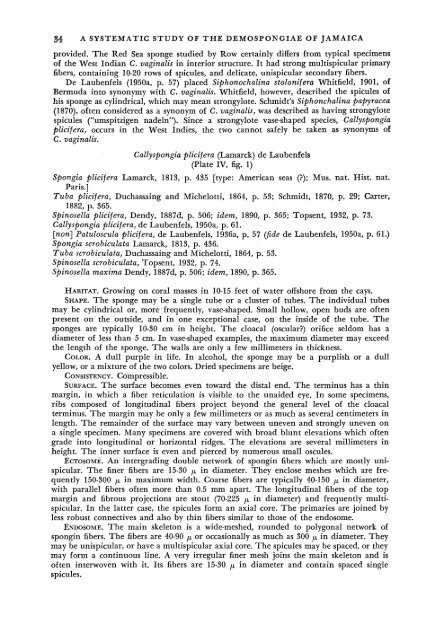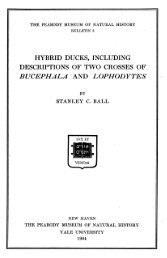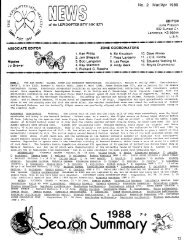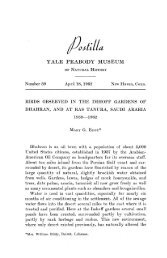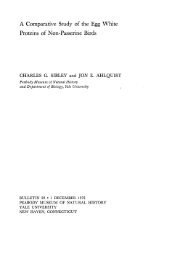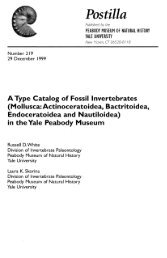Bulletin 20 - Peabody Museum of Natural History - Yale University
Bulletin 20 - Peabody Museum of Natural History - Yale University
Bulletin 20 - Peabody Museum of Natural History - Yale University
You also want an ePaper? Increase the reach of your titles
YUMPU automatically turns print PDFs into web optimized ePapers that Google loves.
34 A SYSTEMATIC STUDY OF THE DEMOSPONGIAE OF JAMAICA<br />
provided. The Red Sea sponge studied by Row certainly differs from typical specimens<br />
<strong>of</strong> the West Indian C. vaginalis in interior structure. It had strong multispicular primary<br />
fibers, containing 10-<strong>20</strong> rows <strong>of</strong> spicules, and delicate, unispicular secondary fibers.<br />
De Laubenfels (1950a, p. 57) placed Siphonochalina stolonifera Whitfield, 1901, <strong>of</strong><br />
Bermuda into synonymy with C. vaginalis. Whitfield, however, described the spicules <strong>of</strong><br />
his sponge as cylindrical, which may mean strongylote. Schmidt's Siphonchalina papyracea<br />
(1870), <strong>of</strong>ten considered as a synonym <strong>of</strong> C. vaginalis, was described as having strongylote<br />
spicules ("umspitzigen nadeln"). Since a strongylote vase-shaped species, Callyspongia<br />
plicifera, occurs in the West Indies, the two cannot safely be taken as synonyms <strong>of</strong><br />
C. vaginalis.<br />
Callyspongia plicifera (Lamarck) de Laubenfels<br />
(Plate IV, fig. 1)<br />
Spongia plicifera Lamarck, 1813, p. 435 [type: American seas (?); Mus. nat. Hist. nat.<br />
Paris.]<br />
Tuba plicifera, Duchassaing and Michelotti, 1864, p. 53; Schmidt, 1870, p. 29; Carter,<br />
1882, p. 365.<br />
Spinosella plicifera, Dendy, 1887d, p. 506; idem, 1890, p. 365; Topsent, 1932, p. 73.<br />
Callyspongia plicifera, de Laubenfels, 1950a, p. 61.<br />
[non] Patuloscula plicifera, de Laubenfels, 1936a, p. 57 (fide de Laubenfels, 1950a, p. 61.)<br />
Spongia scrobiculata Lamarck, 1813, p. 436.<br />
Tuba scrobiculata, Duchassaing and Michelotti, 1864, p. 53.<br />
Spinosella scrobiculata, Topsent, 1932, p. 74.<br />
Spinosella maxima Dendy, 1887d, p. 506; idem, 1890, p. 365.<br />
HABITAT. Growing on coral masses in 10-15 feet <strong>of</strong> water <strong>of</strong>fshore from the cays.<br />
SHAPE. The sponge may be a single tube or a cluster <strong>of</strong> tubes. The individual tubes<br />
may be cylindrical or, more' frequently, vase-shaped. Small hollow, open buds are <strong>of</strong>ten<br />
present on the outside, and in one exceptional case, on the inside <strong>of</strong> the tube. The<br />
sponges are typically 10-30 cm in height. The cloacal (oscular?) orifice seldom has a<br />
diameter <strong>of</strong> less than 5 cm. In vase-shaped examples, the maximum diameter may exceed<br />
the length <strong>of</strong> the sponge. The walls are only a few millimeters in thickness.<br />
COLOR. A dull purple in life. In alcohol, the sponge may be a purplish or a dull<br />
yellow, or a mixture <strong>of</strong> the two colors. Dried specimens are beige.<br />
CONSISTENCY. Compressible.<br />
SURFACE. The surface becomes even toward the distal end. The terminus has a thin<br />
margin, in which a fiber reticulation is visible to the unaided eye. In some specimens,<br />
ribs composed <strong>of</strong> longitudinal fibers project beyond the general level <strong>of</strong> the cloacal<br />
terminus. The margin may be only a few millimeters or as much as several centimeters in<br />
length. The remainder <strong>of</strong> the surface may vary between uneven and strongly uneven on<br />
a single specimen. Many specimens are covered with broad blunt elevations which <strong>of</strong>ten<br />
grade into longitudinal or horizontal ridges. The elevations are several millimeters in<br />
height. The inner surface is even and pierced by numerous small oscules.<br />
ECTOSOME. An intergrading double network <strong>of</strong> spongin fibers which are mostly unispicular.<br />
The finer fibers are 15-30 ^ in diameter. They enclose meshes which are frequently<br />
150-300 fx in maximum width. Coarse fibers are typically 40-150 ^ in diameter,<br />
with parallel fibers <strong>of</strong>ten more than 0.5 mm apart. The longitudinal fibers <strong>of</strong> the top<br />
margin and fibrous projections are stout (70-225 fi in diameter) and frequently multispicular.<br />
In the latter case, the spicules form an axial core. The primaries are joined by<br />
less robust connectives and also by thin fibers similar to those <strong>of</strong> the endosome.<br />
ENDOSOME. The main skeleton is a wide-meshed, rounded to polygonal network <strong>of</strong><br />
spongin fibers. The fibers are 40-90 ^ or occasionally as much as 300 ^ in diameter. They<br />
may be unispicular, or have a multispicular axial core. The spicules may be spaced, or they<br />
may form a continuous line. A very irregular finer mesh joins the main skeleton and is<br />
<strong>of</strong>ten interwoven with it. Its fibers are 15-30 JJL in diameter and contain spaced single<br />
spicules.


